
James Abram Garfield was the 20th president of the United States, serving from March 4, 1881, until his death six months later—two months after he was shot by assassin Charles J. Guiteau. A lawyer and Civil War general, Garfield served nine terms in the United States House of Representatives and is, to date, the only sitting member of the House to be elected president. Before his candidacy for the White House, he had been elected to the U.S. Senate by the Ohio General Assembly—a position he declined when he became president-elect.

The 1856 United States presidential election was the 18th quadrennial presidential election, held on Tuesday, November 4, 1856. In a three-way election, Democrat James Buchanan defeated Republican nominee John C. Frémont and Know Nothing nominee Millard Fillmore. The main issue was the expansion of slavery as facilitated by the Kansas–Nebraska Act of 1854.
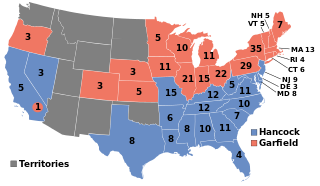
The 1880 United States presidential election was the 24th quadrennial presidential election, held on Tuesday, November 2, 1880, in which Republican nominee James A. Garfield defeated Winfield Scott Hancock of the Democratic Party. The voter turnout rate was one of the highest in the nation's history. Garfield was assassinated during his first year in office, and he was succeeded by his vice president, Chester A. Arthur.

The 1884 United States presidential election was the 25th quadrennial presidential election, held on Tuesday, November 4, 1884. It saw the first Democrat elected President of the United States since James Buchanan in 1856, and the first Democratic president to hold office since Andrew Johnson, who assumed the presidency after the assassination of Abraham Lincoln. Governor Grover Cleveland of New York defeated Republican James G. Blaine of Maine. The election was set apart by unpleasant mudslinging and shameful personal allegations that eclipsed substantive issues, for example, civil administration change. It was a historically significant election, as Cleveland was the only Democratic president between Andrew Johnson, who left office in 1869, and Woodrow Wilson, who began his first term in 1913, representing a disruption of the period of Republican domination of the presidency between Reconstruction and the Great Depression. Cleveland was the first Democrat in 28 years to be elected since Buchanan was elected to the presidency.

The 1924 United States presidential election was the 35th quadrennial presidential election, held on Tuesday, November 4, 1924. In a three-way contest, incumbent Republican President Calvin Coolidge won election to a full term. Coolidge was the second vice president to ascend to the presidency and then win a full term.
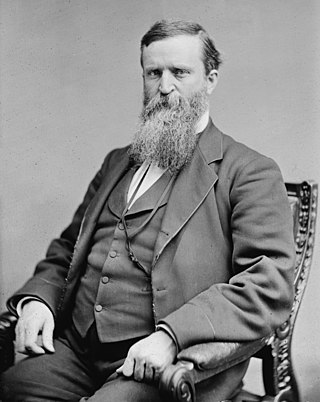
James Baird Weaver was an American politician who was a member of the United States House of Representatives and two-time candidate for President of the United States. Born in Ohio, he moved to Iowa as a boy when his family claimed a homestead on the frontier. He became politically active as a young man and was an advocate for farmers and laborers. He joined and quit several political parties in the furtherance of the progressive causes in which he believed. After serving in the Union Army in the American Civil War, Weaver returned to Iowa and worked for the election of Republican candidates. After several unsuccessful attempts at Republican nominations to various offices, and growing dissatisfied with the conservative wing of the party, in 1877 Weaver switched to the Greenback Party, which supported increasing the money supply and regulating big business. As a Greenbacker with Democratic support, Weaver won election to the House in 1878.
Members of the Catholic Church have been active in the elections of the United States since the mid 19th century. The United States has never had religious parties. There has never been an American Catholic religious party, either local, state or national.
The Employee Free Choice Act is the name for several legislative bills on US labor law which have been proposed and sometimes introduced into one or both chambers of the U.S. Congress.
The 1892 Democratic National Convention was held in Chicago, Illinois, June 21–June 23, and nominated former President Grover Cleveland, who had been the party's standard-bearer in 1884 and 1888. This marked the last time a former president was renominated by a major party. Adlai E. Stevenson of Illinois was nominated for vice president. The ticket was victorious in the general election, defeating the Republican nominees, President Benjamin Harrison and his running mate, Whitelaw Reid.
The 1880 Democratic National Convention was held June 22 to 24, 1880, at the Music Hall in Cincinnati, Ohio, and nominated Winfield S. Hancock of Pennsylvania for president and William H. English of Indiana for vice president in the United States presidential election of 1880.
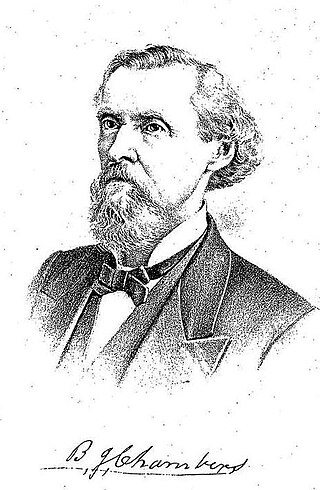
Barzillai Jefferson Chambers was an American surveyor, lawyer, and politician of the Gilded Age. Born in Kentucky, he moved to Texas to join its war for independence against Mexico. Chambers stayed in Texas after its independence and annexation by the United States, earning a living as a surveyor and farmer in Johnson County. In the American Civil War, he served briefly in the Confederate army, then returned to his farming and business interests, becoming part-owner of a bank in his hometown of Cleburne. In the 1870s, Chambers became concerned with farming and monetary issues in politics, eventually joining the nascent Greenback Party in 1877. He ran unsuccessfully for Vice President on the Greenback ticket with presidential nominee James B. Weaver of Iowa in 1880. The Greenback nominees finished in a distant third place, receiving only 3.3% of the popular vote and no electoral votes. After the election, Chambers remained active in Greenback politics in Texas until the party's demise in the late 1880s. He died at his home in Cleburne in 1895.
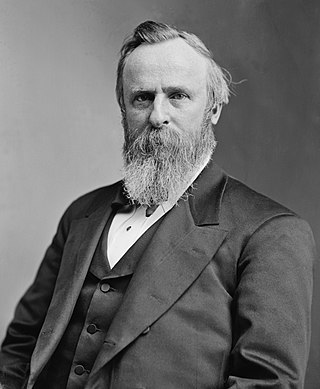
The presidency of Rutherford B. Hayes began on March 4, 1877, when Rutherford B. Hayes was inaugurated as President of the United States, and ended on March 4, 1881. Hayes became the 19th president, after being awarded the closely contested 1876 presidential election by Republicans in Congress who agreed to the Compromise of 1877. That Compromise promised to pull federal troops out of the South, thus ending Reconstruction. He refused to seek re-election and was succeeded by James A. Garfield, a fellow Republican and ally.

The 1880 United States presidential election in California was held on November 2, 1880, as part of the 1880 United States presidential election. State voters chose six representatives, or electors, to the Electoral College, who voted for president and vice president.
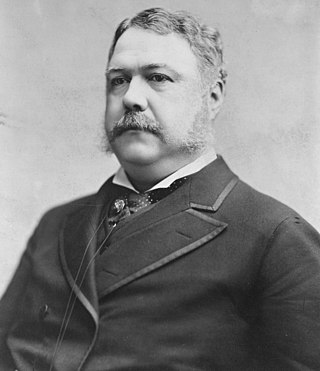
Chester Alan Arthur was an American politician who served as the 21st president of the United States from 1881 to 1885. He was a Republican lawyer from New York who previously served as the 20th vice president under President James A. Garfield. Arthur assumed the presidency after Garfield's death on September 19, 1881, and served the remainder of his term until March 4, 1885.

John Sherman was an American politician from Ohio throughout the Civil War and into the late nineteenth century. A member of the Republican Party, he served in both houses of the U.S. Congress. He also served as Secretary of the Treasury and Secretary of State. Sherman sought the Republican presidential nomination three times, coming closest in 1888, but was never chosen by the party.

The 1880 Greenback Party National Convention convened in Chicago from June 9 to 11, 1880, to select presidential and vice presidential nominees and write a party platform for the Greenback Party in the United States presidential election of 1880. Delegates chose James B. Weaver of Iowa for President and Barzillai J. Chambers of Texas for Vice President.

After serving one term as U.S. President, Rutherford B. Hayes announced that he would not seek re-election in 1880. Thus, the 1880 election ended up being fought between Republican James A. Garfield, the winner, and Democrat Winfield Scott Hancock.

The 1908 U.S. Presidential election occurred in the backdrop of the Progressive achievements of U.S. President Theodore Roosevelt's second term as well as against the U.S. recovery following the Panic of 1907. In this election, Roosevelt's chosen successor, Republican William Howard Taft, ran in large part on Roosevelt's Progressive legacy and decisively defeated former Congressman and three-time Democratic U.S. Presidential candidate William Jennings Bryan. Overall, the 1908 presidential campaign and election were about labor issues, trusts, campaign finance reform, imperialism, and corruption.

The 1880 United States presidential election in Nevada took place on November 2, 1880, as part of the 1880 United States presidential election. State voters chose three representatives, or electors, to the Electoral College, who voted for president and vice president.

The 1880 United States presidential election in Colorado took place on November 2, 1880, as part of the 1880 United States presidential election. Voters chose three representatives, or electors to the Electoral College, who voted for president and vice president.
















